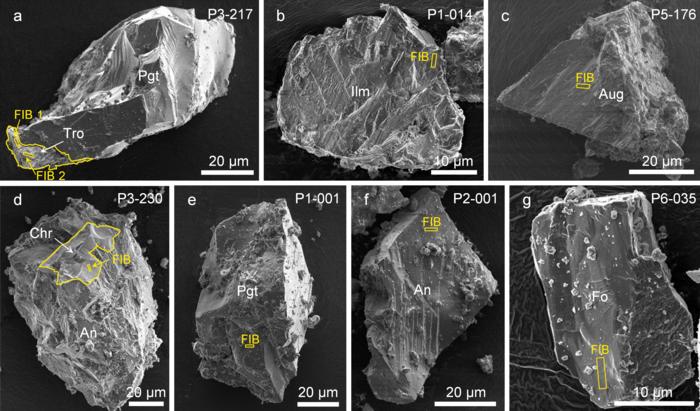In a groundbreaking study led by Dr. Xian Haiyang and Dr. Zhu Jianxi from the Guangzhou Institute of Geochemistry, significant advances have been made in our understanding of lunar geology, particularly concerning the differences in space weathering processes between the Moon’s near and far sides. The research stems from the historic Chang’e-6 mission, which successfully retrieved samples from the lunar farside and returned them to Earth on June 25, 2024. This mission marks a pivotal moment in lunar exploration, as it is the first time humanity has directly collected samples from this mysterious region of the Moon.
The Chang’e-6 samples are unique not only in their origin but also in their implications for the study of lunar geology and space weathering. After returning to Earth, Dr. Xian and his team embarked on an intricate analysis of these samples, utilizing cutting-edge technologies at the Electron Microscopy Center. In August, recognizing Dr. Xian’s previous accolades from the Chang’e-5 mission, he was entrusted with these precious lunar samples, which have the potential to unlock secrets about the lunar environment that were previously inaccessible.
Under Dr. Xian’s mentorship, graduate student Lin Jiarui took on the daunting task of meticulously analyzing the samples using scanning electron microscopy (SEM). The objective was to preserve as much surface information as possible while ensuring that the fine details of the mineralogy were examined thoroughly. The team opted for a technique in which fine-grained lunar powder was distributed on conductive adhesive, followed by the deposition of a thin carbon film, allowing for observations at a voltage of just 3 kV. This careful methodology resulted in observations of fewer melt droplets and splashes on the surfaces of the lunar samples compared to the Apollo samples.
One of the premier findings of the study was related to the surface mineralogy of feldspar. During subsequent analyses using transmission electron microscopy (TEM), Lin and her team prepared a feldspar particle designated P2-001 utilizing focused ion beam (FIB) techniques. Intriguingly, they discovered a notable absence of nanophase metallic iron (npFe⁰) particles, which are typically abundant in the feldspar surfaces of Apollo samples, indicating a variance in the space weathering processes experienced by the two sets of samples.
The implications of this finding are profound. The typical surface characteristics of feldspar in lunar samples from the Apollo missions display a vapor-deposited layer from micrometeorite impacts that generate npFe⁰. In contrast, the Chang’e-6 samples exhibited a different compositional stability, suggesting that the space environment of the lunar farside plays a crucial role in shaping mineral surfaces. These observations prompted further investigation into the relationship between mineral composition and the effects of solar wind radiation.
Lin Jiarui also delved into quantifying the thickness of amorphized layers and measuring npFe⁰ grain sizes within the samples. Through careful documentation of solar wind tracks found in pyroxene and olivine, the research team endeavored to estimate the duration of solar wind exposure experienced by the lunar particles. Their analysis revealed that the solar wind exposure time for Chang’e-6 samples closely resembles that of the minimum observed in Apollo 11 samples. However, the incredible revelation was that the npFe⁰ grain sizes in the Chang’e-6 samples were larger, which may suggest a distinctive interaction between solar wind radiation and the mineral constituents of the lunar farside.
The findings underscore the differences in solar wind influence across various lunar regions. The Moon’s near side occasionally enters Earth’s magnetotail, where Earth’s magnetic field provides a shield against solar wind, contrasting sharply with the incessant exposure faced by the lunar farside. The varying impact velocities experienced by lunar surface regions, dictated by the Moon’s orbit, further complicate this picture, influencing how micrometeoroid impacts interact with the lunar surface.
Delving deeper, the study reveals that micrometeoroid impacts and solar wind radiation are the primary forces behind space weathering on the lunar surface. However, the interplay between effective sputtering rates from solar wind exposure and vapor deposits from micrometeorite impacts can’t be overlooked. The discoveries stemming from the Chang’e-6 samples suggest that the solar wind’s impact could be more pronounced on the lunar farside than previously understood, illustrating the importance of environmental factors in regulating space weathering processes.
This research, underpinned by the analysis of lunar samples, sheds light on the broader implications of space weathering. Since the first images of the lunar farside were taken in 1959, the nature of its topography has suggested a stark contrast with the nearside. The recent findings, drawn from the Chang’e-6 samples, provide direct, sample-based evidence supporting the hypothesis that the lunar space environment exhibits similar dichotomies. These insights extend beyond lunar studies, offering valuable knowledge applicable to understanding the surface evolution of other celestial bodies lacking atmospheres.
As the scientific community continues to unravel the complexities of space weathering, the discoveries from the Chang’e-6 mission establish a strong foundation for future research. With new techniques and findings, we are poised to deepen our understanding of lunar geology and the fundamental physical processes at work in shaping the surfaces of airless bodies throughout our solar system.
In essence, the Chang’e-6 mission and the subsequent analysis of its samples serve not merely as a milestone in lunar exploration but as an open door to new scientific inquiries that could reshape our understanding of planetary surfaces and their interactions with external environmental factors. The impact of this research will reverberate through future explorations both on the Moon and beyond.
Subject of Research: Space weathering differences between the near and far side of the Moon based on Chang’e-6 samples
Article Title: Differences in Space Weathering Processes: Insights from Chang’e-6 Lunar Samples
News Publication Date: October 2024
Web References: National Science Review
References: To be determined after peer review.
Image Credits: ©Science China Press
Keywords
Lunar samples, Chang’e-6, space weathering, solar wind, lunar geology, feldspar, solar wind exposure, micrometeoroids.




